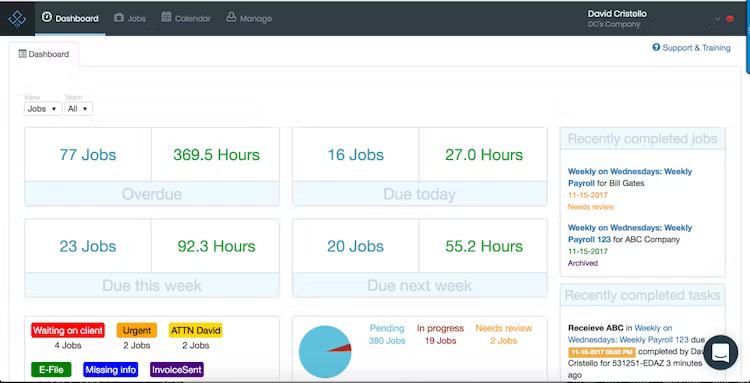How to Create an Ironclad Bookkeeping Workflow For Your Firm

Every once in a while, in a corner of my office or in a rarely used file cabinet, I’ll find a pad of ledger paper. Those green and white lined, extra-large sheets of paper have been out of style for decades but served their purpose well for decades before that.
After dusting off the pad and moving it aside, I’ll find the file I was looking for. Organizational systems have come a long way since ledger paper was in vogue, and it’s rare that I need to hunt down a paper file these days. But, while digital files have made life much easier, how do you make sure that your digital files and projects aren’t falling through the cracks?
It takes a solid plan and system to ensure that projects are getting done, clients are happy, and I’m working as efficiently as possible. This is why implementing a bookkeeping workflow for my team has allowed me to monitor projects, allocate work to my team, and free up time I would have spent tracking down files.
What is a Bookkeeping Workflow?
A bookkeeping workflow is a set of predefined tasks for your teams related to projects. Each project is broken up into various steps that can be assigned to a team member or multiple team members. Depending on which system is used, team members are automatically notified that they have been assigned a task or have an upcoming deadline.
Workflows allow managers to see who is currently working on a project, which steps are involved in the project, how the project is progressing, how much time has been spent on the project, and when the project is projected to be complete.
A bookkeeping workflow often includes options for repetitive tasks such as monthly or quarterly bookkeeping that are recreated automatically once the prior month is complete.
Even though a bookkeeping or accounting project will start off with a standard workflow, the workflow for each project can be tailored based on the client’s specific needs. The workflows can be detailed or broad depending on the complexity of the project and the level of detail that the manager or team member prefers.
There are various options for workflows from simple Excel spreadsheets to fully integrated workflow systems such as Jetpack Workflow. Each system has different strengths and weaknesses. The right workflow for your team will depend on the number of projects, the size of the projects, and the number of team members involved.
The key to a successful workflow is making sure that the entire team is on board with using the workflow system and that the system isn’t so complex that it falls out of favor after awhile.
Why You Need a Bookkeeping Workflow
Most of us became bookkeepers and accountants because we love the work. We enjoy ensuring that the bank is reconciled (who hasn’t delighted in reaching $0 variance when completing a tough reconciliation?). We are happy to see that the payments between accounts are recorded correctly. And, at the end of the day, we like presenting financial statements that have been carefully prepared.
It’s the work we enjoy. The planning — not as much.
As accountants, we are constantly juggling multiple projects, client requests, and deadlines. Though we tend to thrive under pressure, having a system is key to avoiding dropping anything.
To-do lists are great and have their place, but in a field like accounting where repetition and regular tasks are key, it’s important to ensure that you’re not overlooking a project that the client is counting on you to finish.
Because so much accounting work is done online whether through importing statements into QuickBooks online or logging into a client’s bank account to retrieve a statement, there aren’t always automatic reminders that a task is due.
This is why a workflow is crucial. Having automatic reminders set for upcoming tasks allows you to free up your mental capacity for the work itself.
If you oversee a team of accountants and bookkeepers, having a workflow system means that you can monitor project progress online without having to task your team members for updates. Fewer interruptions lead to more efficient work and add to your bottom line.
3 Common Workflow Buckets During the Bookkeeping Workflow
Prior to starting any project, it’s important to determine which steps are involved and which team members will be participating in the project. This is where a workflow comes in handy and can help you keep organized as well as eliminate inefficiencies.
There are three main buckets of tasks that occur in each bookkeeping project (though each accounting team defines their buckets a little differently.)
Bucket 1: Request and Receive
For anyone who has taken an accounting class, you know that the biggest difference between the textbook cases and the actual accounting experience is that in class, you’re given all the necessary information upfront.
This first bucket consists of determining which pieces of information or documents are needed, requesting them from the client (or from several institutions), and reviewing all documentation, transactions, and invoices completely. Document collection often takes several requests and follow-ups before it’s complete.
Bucket 2: Process and Fulfill
Once all the documentation has been received, it’s time to start processing the accounting information. This part of the process involves data entry, reconciliation, and numerous journal entries.
It’s common to find that there is additional information needed that wasn’t apparent at the start of the projects. You may spot payments on a loan and need to go back and ask for loan statements, or the client purchased a new fixed asset that requires additional information to be properly categorized. There are any number of reasons that you end up circling back to the client before finishing the accounting work on the project.
At the end of this stage, the project is sent to the client for review and feedback.
Bucket 3: File and Follow-up
Once all the information has been processed and you’ve received all the necessary clarification from the client, you can complete your final review to ensure the project is complete to your standards. Then the project is filed away (digitally or on paper) along with backup documentation.
You now have the option to schedule the next iteration of the project if it’s a recurring task or to reach out to your client to see if they need other services.
Resources to Help You Design a Workflow
There are numerous options for building a bookkeeping workflow from scratch. You can set up a project list in Google Sheets or Excel. You could use a task list.
But Jetpack Workflow has done a lot of the heavy lifting for you and built a workflow solution designed for the accounting industry. Depending on whether you need templates to get you started or a software solution to oversee a dispersed team, Jetpack can get you started.
Free Workflow Templates
Want to skip making your own workflows for your team? Download our 32 free workflow templates today, and organize your bookkeeping workflow templates all in one place, without starting from scratch.
Get everything you need to manage projects and meet deadlines.
Subscribe to our weekly newsletter, and get 32 free accounting workflow templates today!
sign me up!
Workflow Management Software
Though templates are a great start to getting organized, for teams that need a more robust solution, new technology like a workflow management software is a great tool.
Managers love that they can see real-time updates and progress reports for multiple projects and distribute work evenly to their teams. Team members love that they know what the expectations are for projects and can visually prioritize their most important tasks.
Jetpack Workflow offers a free 14-day trial because they’re confident that within two weeks you’ll be convinced, and you’ll see how simple it is to streamline your practice management.
“We can’t live without it. It tracks everything we need in a way that nothing ever slips by… I am 100% positive Jetpack has helped grow my business (25% growth last year and looking even better this year).” – Wendy Wray












